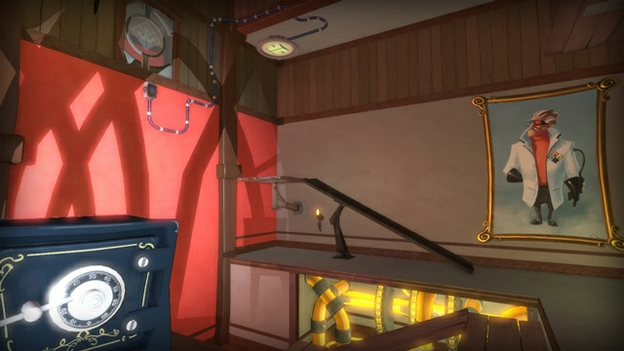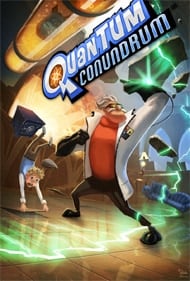The First-Person Puzzle Genre Returns
Quantum Conundrum is an upcoming first-person puzzle game in development at Airtight Games and set to be published by Square Enix. Yes, first-person puzzle games are rare. In fact, the only other first-person puzzler you might be able to think of off the top of your head is Portal, a comparison that is incredibly appropriate here. You see Kim Swift, former lead designer on Portal, is also the lead designer for Quantum Conundrum, and the two games are alike in many ways. Just like in Portal, you are given several puzzle objectives, from pushing switches to forming paths and ladders in an attempt to reach each level’s goal. However, while Portal’s main gameplay element involved linking two areas of space together, Quantum Conundrum screws with the laws of physics in a much more profound way.

The main character of Quantum Conundrum has a glove that allows him to switch between different “dimensions.” Each dimension is laid out exactly the same as our own normal reality, but its laws of physics greatly differ. For example, in the fluffy dimension, objects are ten times lighter than they are in the real world. They are also ten times as fragile. This allows the main character to easily pick up pianos as if they were sheets of paper. The heavy dimension is the exact opposite. There, objects are ten times heavier than normal and are much more durable. Simple everyday objects like a cardboard box will become heavy enough to push a floor switch in the heavy dimension. In addition, there is also the slow dimension, where time moves twenty times slower, and the reverse dimension, where gravity flows upward.
This dimension-swapping gameplay is the central theme of Quantum Conundrum. Simple puzzles will have you swapping between dimensions to make objects heavier or lighter in order to press switches. However, more complex puzzles will involve other aspects of dimensional physics. For example, one area of the game puts several rows of blocks before a ledge that you have to climb up to. There is a laser sweeping back and forth across the blocks, destroying them as it hits them. Eventually, the laser eradicates all of the blocks before they renew themselves once more.

It’s fairly obvious looking at this puzzle that you need to somehow use the blocks to get up to the upper ledge, but you can’t push or pull any of them. Instead, you have to use your dimension shifting to build yourself a step ladder. When you shift into the heavy dimension, the blocks cannot be destroyed by the laser. Your goal is to be in the normal world whenever the laser passes over a block that needs to be destroyed, and in the heavy world at all other times. This easily allows you to build a staircase to reach the upper ledge.
However, you don’t get access to every dimension right at the start. At the beginning, you only have access to our own normal world. To open up other dimensions you have to find dimensional batteries in the puzzle rooms and slot them into generators. However, getting to one of these batteries generally tends to be a puzzle in itself. Simple puzzles, like picking up a heavy object in the fluffy dimension, throwing it, and then shifting back mid-flight to make it smash a window, become relatively commonplace as more multifaceted puzzles start blocking your progress.

Beyond the incredibly interesting physics-based gameplay, the game’s aesthetic is easily one of its biggest selling points. When you shift between dimensions, everything around you changes. In the fluffy dimension, for example, metal safes become fluffy stuffed facsimiles of their former selves. Portraits of scientists in lab coats change to pictures in the same characters dressed in fluffy bunny pajamas. Similarly, everything in the heavy dimension has a harsh metallic look to it, and so forth.
Beyond the incredibly interesting physics-based gameplay, the game’s aesthetic is easily one of its biggest selling points. When you shift between dimensions, everything around you changes. In the fluffy dimension, for example, metal safes become fluffy stuffed facsimiles of their former selves. Portraits of scientists in lab coats change to pictures in the same characters dressed in fluffy bunny pajamas. Similarly, everything in the heavy dimension has a harsh metallic look to it, and so forth.
Game Features:
